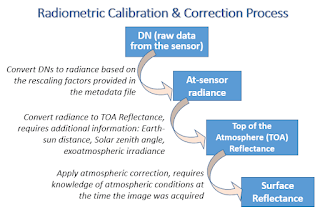Radiometric correction in remote sensing is a crucial process that aims to remove or reduce variations in the recorded radiance values of an image, ensuring that the data accurately represents the reflectance properties of the Earth's surface. This correction is essential for extracting meaningful information from remotely sensed imagery.
1. Source of Radiometric Error:
Radiometric errors in remote sensing can originate from various sources, including:
a. Atmospheric Effects: The Earth's atmosphere can scatter and absorb incoming sunlight and reflected light from the surface. These atmospheric effects can introduce errors in radiance values, particularly in the blue and ultraviolet spectral regions.
b. Sensor Characteristics: Different sensors have varying spectral and radiometric characteristics, leading to inconsistencies in radiance measurements.
c. Satellite Orbits: Variations in the satellite's position, speed, and angle relative to the Earth's surface can affect the radiance recorded by the sensor.
d. Ground Reflectance Variations: Changes in ground cover, terrain, and surface properties can result in varying reflectance values across an image.
e. Calibration Issues: Sensor calibration drift over time or inaccuracies in the calibration process can introduce radiometric errors.
2. Types of Radiometric Correction:
There are several methods for radiometric correction in remote sensing, depending on the specific sources of error and the data characteristics. Here are some common types:
a. Dark Object Subtraction (DOS): This method involves identifying the darkest objects in the image, which are assumed to be black, non-reflective surfaces. The radiance values of all pixels are adjusted based on the radiance of these dark objects to correct for sensor-specific errors.
b. Atmospheric Correction: Atmospheric correction algorithms attempt to estimate and remove the influence of the atmosphere on radiance values. They use atmospheric models and sensor data to adjust the recorded values to approximate surface reflectance.
c. Calibration Correction: This correction addresses sensor-specific errors by using calibration data to rescale and adjust the recorded radiance values.
d. Relative Radiometric Correction: In this approach, image-to-image variations are corrected by comparing and normalizing radiance values across different scenes or time periods.
e. Absolute Radiometric Correction: This method aims to provide accurate radiometric values by considering sensor-specific parameters and calibration data, making the data directly comparable across different sensors and time periods.
f. Top-of-Atmosphere (TOA) Reflectance: TOA reflectance correction calculates the reflectance values at the top of the atmosphere by removing atmospheric effects. This correction is valuable for comparing images acquired under varying atmospheric conditions.
Effective radiometric correction enhances the utility of remote sensing data for applications such as land cover classification, change detection, and environmental monitoring, by ensuring that the imagery accurately reflects the Earth's surface properties while minimizing errors caused by various sources.

Comments
Post a Comment